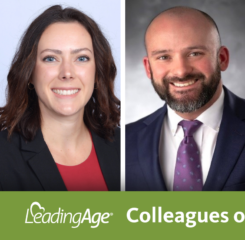Join our Campaign to Bring Interoperability & HIE to LTPAC
A movement is underway to obtain funding to enable the use and exchange of electronic health information with long-term and post-acute care (LTPAC) providers. People in the aging field are encouraged to join the effort.
LTPAC Providers Excluded from Federal Funding
Interoperability is critical across the care continuum. However, LTPAC providers are excluded from receiving federal funding through the Health Information Technology for Economic Clinical Health (HITECH) Act, which supports the electronic use and exchange of interoperable health information. The 2009 HITECH Act funding helped hospitals and physicians invest in electronic health records (EHRs).
Excluding LTPAC providers created an uneven playing field in the healthcare eco-system that makes it challenging to treat the nation’s older adults, chronically ill, and vulnerable patients. As a result of technology gaps, it is more difficult to broaden data exchange between stakeholders, especially during instances of shared care and transitions of care between hospitals and the LTPAC sector.
Majd Alwan, senior vice president of technology and business strategy at LeadingAge and executive director of LeadingAge CAST, presented on this topic recently, along with John Knapp, vice president of advocacy at Premier Inc at the LeadingAge Leadership Summit. Daniel Ciolek, associate vice president of therapy advocacy at American Health Care Association (AHCA), who is actively participating in this effort and developed content for the session, was unfortunately unable to join the panel due to an arising health issue. See the presentation slides.
The Pandemic’s Effect
The pandemic has highlighted specific challenges that nursing homes, home health agencies, and other LTPAC providers face in containing the spread of infectious diseases; exchanging and sharing data with other providers, including infection, COVID-19 tests, and vaccination status; and fulfilling various reporting requirements.
The pandemic also highlighted limitations around quality, safety, infection control, and public health reporting. A clear need exists for a comprehensive cross-continuum infection prevention and antimicrobial stewardship workflow, which could be utilized by infection preventionists, pharmacists, and other clinicians for clinical decision support, patient care, patient safety monitoring, and public health reporting.
Legislatively appropriated funding is necessary to ensure nationwide interoperability of health IT and data exchange and sharing across the care continuum, including technological functionality to improve quality of care, patient safety, and infection control during this pandemic and beyond.
Advocacy Efforts
The following groups have joined to raise awareness of the issue:
- LeadingAge & LeadingAge CAST
- American Health Care Association (AHCA)
- Premier Healthcare Alliance
- National Association for Home Care & Hospice (NAHC)
- American Medical Directors Association (AMDA)
- National PACE Association
- American Health Information Management Association (AHIMA)
- American Society of Consultant Pharmacists (ASCP)
- Healthcare Information and Management Systems Society (HIMSS)
Together, they have created a one-pager with background on the issues. They submitted group comments to the U.S. House of Representatives’ Healthy Future Modernization Subcommittee Task Force. Group members also met with key committees of jurisdiction and had a preliminary discussion with the Office of the National Coordinator (ONC) for Health Information Technology. Discussions have been positive.
Summary of the Asks
Below is the summary of our asks:
- Authorize funding for LTPAC providers to adopt interoperable Health IT with a focus on patient care and safety, including infection control and prevention.
- Direct HHS/CMS to establish a financial incentives program for LTPAC providers making the transition to interoperable EHRs and technology aimed at improving patient care and safety across the continuum, including electronic clinical surveillance technology (ECST).
- Direct funding to ONC to ensure proper bidirectional interoperability between acute care (e.g., hospitals and physicians), LTPAC providers, and other ancillary providers (e.g., therapy, pharmacy, etc.). Resources would support the implementation, use, and sustainability of interoperable EHRs, infection control, and electronic clinical surveillance technology (ECST):
- Build out an Interoperability Verification Program for the LTPAC sector to ensure cross-continuum information exchange and alignment, where necessary with acute care.
- Develop minimum criteria that the EHRs and ECST would need for LTPAC providers to receive funding support.
- Adapt, enhance, expand and/or and implement an LTPAC Informatics & Technology Workforce Development Program to include training on and dissemination of information on best practices to integrate health information technology, including electronic health records, into LTPAC care delivery.
- Adapt, enhance, expand and/or implement an LTPAC Technical Assistance Program, such as via health information exchanges or other entities, to support LTPAC providers in their efforts to acquire, implement, adopt, and effectively use interoperable health information technology and information exchange tools.
See how our requested funding areas align with, and go beyond the recent National Academies of Science, Engineering, and Medicine Report’s recommendations to improve care in nursing homes, and even have suggestions to avoid the pitfalls of the HITECH Act Program.
How You Can Help
To advance interoperability that leads to better care of older adults, please take the following actions:
- Leverage your connections in your state and district to identify champions in Congress to support this effort. Leverage your lobbyists, if applicable. Mention the effort and share the one pager with your representatives.
- Leverage your connections to make other organizations aware and supportive of this effort.
- Help collect anecdotes or data on
- How filling these gaps would be helpful for your patients or residents,
- Challenges that the technology gaps create,
- Efficiencies these technologies would create, and
- Anything else you would be willing to share.
- Help us identify Congressional Champions willing to sponsor/ co-sponsor a bill to address this long-overdue issue.
Learn More at the Virtual Collaborative Care Tech Summit, June 7-8
Attend the upcoming Virtual Collaborative Care Tech Summit, June 7-8, 2022, to hear ONC’s perspective on empowering clinicians with Health IT.
Keynote: Empowering Clinicians with Health IT: ONC’s Education Programs
Tuesday, June 7
1:00 – 1:45 p.m.
Speaker: Dr. Thomas Keane, Senior Advisor, U.S. Dept of Health and Human Services | Office of the National Coordinator for Health Information Technology (ONC)
- Review ONC’s efforts in preparing the healthcare workforce of the future and arming them with appropriate health IT skills.
- Discuss the impacts the past programs have made and hear about the lessons learned.
- Explore potential opportunities for educating and/or training the workforce in the long-term and post-acute care sector in health IT.
Moderator: Brenda Akinnagbe, ONC Staff Lead
You will also hear about the impact of Health IT on efficiencies.
Session: Efficiencies Gained from Using Health IT Correctly!
Tuesday, June 7
2:15 – 3:00 p.m.
Speakers: Gregory Alexander, PhD, RN, FAAN, FACMI, FIAHSI, Helen Young CUPHSONAA Professor, Columbia University, School of Nursing, and a member of the LTPAC Health IT Collaborative; additional speaker invited.
- Hear about the role of correctly implemented health IT solutions in reducing clinicians’ burdens, burn-out, and time spent on documentation.
- Explore case studies showing how providers are using health IT to reduce staff’s burdens, drive efficiencies, and improve outcomes.
- Discuss a myriad of the key success factors for maximizing the efficiencies of health IT.
Be sure to join us—register today!

Most Recommended
November 08, 2024
 HOTMA: New Rules for Housing
HOTMA: New Rules for Housing
November 06, 2024
 Colleagues on the Move, November 6, 2024
Colleagues on the Move, November 6, 2024
November 06, 2024
 Analysis: What Does the Final CY2025 Home Health Rule Include?
Analysis: What Does the Final CY2025 Home Health Rule Include?
October 29, 2024
Katie Smith Sloan Urges Members to Build a Movement, Take Action
Recently Added
December 04, 2024
Second OIG Infection Preventionist Compliance Report Released
December 04, 2024
 Colleagues on the Move, December 4, 2024
Colleagues on the Move, December 4, 2024
November 27, 2024



